October 12, 2021
A good friend of mine—an expert in the field who is highly knowledgeable about health and biology—recently lost 15 pounds while he had COVID.
Now, this was not a good thing.
While many people are of course looking to drop their weight, in this case, the weight loss (and resultant muscle mass), was unintended and unwanted muscle loss—resulting in baggy t-shirts, a disappeared butt, far fewer push-up and pull-up capability, and a drop in performance across just about every sport he played. This friend asked me to share resources for building his muscle mass back up and maintaining it long-term.
Because the research has unequivocally shown the health and anti-aging benefits of resistance training (more on that later), I was able to send him plenty of stuff. In addition to devoting an entire chapter in my book Boundless to muscle-building—titled Sexy Forever: How To Build Functional Muscle For Life—I've covered building and maintaining muscle mass in detail in the following articles:
- Ben Greenfield's Entire Muscle Building Program Unveiled: Top 6 Muscle Building Workouts, Diet For Building Muscle Without Gaining Fat & The Best Supplements For Muscle Mass.
- Biohack Your Body For Muscle Gain & Fat Loss: Part 1 – Ben Greenfield’s Top Recommended Science, Gear & Tools For Building The Ultimate Human.
- Biohack Your Body For Muscle Gain & Fat Loss: Part 2 – Ben Greenfield’s Top Recommended Science, Gear & Tools For Building The Ultimate Human.
- Advanced Muscle Building With Science: How To Biohack Body Composition With Stem Cells, NAD & One Workout Per Week.
- The 19 Best Full-Body Workouts Ben Greenfield Uses For His Year-Round Exercise Routine.
- Inside Isometrics: The Performance-Enhancing, Muscle-Boosting, Long-Forgotten Exercise Modality That You Can Do Anywhere.
- Biohacking Muscle Growth: How To Maximize Anabolism & Muscle Hypertrophy Using Targeted Delivery Of Nutrients To Muscle Tissue During Exercise, With Professional Bodybuilder Milos Sarcev.
- Nerdy Ways To Lose Fat, Build Muscle & Maintain A Nice Body As You Age.
- Is This The World’s Most Efficient, Biohacked Workout? The New Full-Body Electro Muscle Stimulation Science by Katalyst (& How To Build Muscle In 20 Minutes) With Bjoern Woltermann.
Building and maintaining muscle mass is desirable for reasons far beyond having biceps you're proud of flexing. Resistance training by means of lifting weights is a powerful tool for defying age as well. And while there are plenty of things you can do to look, perform, and feel your best both now and well into your senior years, resistance training may in fact be the quickest, most powerful strategy that you can implement right now.
The best part? You don’t have to spend hours in the gym, day in and day out, in order to reap the longevity benefits that accompany lifting weights.
In this article, you’ll discover what science says about weightlifting’s effects on aging; two simple but potent workouts for building lean, functional muscle in the most efficient, sustainable way possible; some non-traditional methods for building and maintaining muscle; and much more.
The Truth About Lifting Weights
As I said, I've long been a proponent of the benefits of lifting.
Resistance training is known to have a variety of benefits, such as accelerated fat loss and improved metabolic function.
While there are a multitude of benefits that result from resistance training, one of the most advantageous, in my opinion, is its protective effect on your DNA.
Your DNA is protected by telomeres, strands of genetic material that twist up into a cap at each end of each chromosome in your body. Telomeres guard your DNA against damage from cell division, oxidative stress, inflammation, and other metabolic processes that can be detrimental to chromosomes. As you age, your telomeres unwind and get shorter and shorter. The Telomere Theory of Aging theorizes that this slow destruction of your telomeres contributes to many of the diseases and neurodegenerative conditions that we associate with aging.
Following is a brief review of the important research out there, which includes studies I have cited in the past but which are important to revisit as they have established the relationship between telomeres, aging, and heavy lifting.
In the study “Resistance Exercise Reverses Aging in Human Skeletal Muscle,” it was proven that six months of progressive resistance training, i.e. “lifting heavy stuff,” made the gene expression pattern of aging mitochondria significantly younger. Essentially, lifting weights reversed nearly 40 years of aging.
Another group of researchers, hypothesizing that telomeres might indicate overall biological age, studied the telomeres of 2,401 twins via blood samples. They also had the twins fill out questionnaires on physical activity level, smoking status, disease status, and socioeconomic status.
Unsurprisingly, the researchers found that telomere length decreased with age. But they also found that the men and women who were physically active had longer telomeres than those who were sedentary—even after adjusting for age, weight, disease, socioeconomic status, and smoking. Not only that, but participants who spent more than three hours each week engaged in vigorous physical activity (such as lifting weights) had longer telomeres than subjects ten years younger. This was a significant finding because these differences weren’t due to genes, since the subjects were twins, but rather to the lifestyle factor of exercise.
Another study compared telomere lengths in a group of powerlifters who had trained for an average of eight years against those of a group of healthy, active subjects who had no history of strength training. Telomere lengths in the powerlifters were significantly higher than those of the control group, and telomere length was positively correlated to the powerlifters’ individual records in the squat and deadlift!
Finally, another study has shown that older adults who met twice-weekly strength-training guidelines showed lower odds of dying. Data from the ‘97-’01 National Health Interview Survey, which includes more than 30,000 adults aged 65+, showed that older adults who engaged in strength-training twice a week had 46% lower odds of dying for any reason than those who did not, and they also had significantly lower odds of dying from cancer and cardiac events. Even after adjusting for demographic variables and controlling for physical activity level, people who reported strength training saw a greater mortality benefit than those who reported physical activity (non-strength training) alone.
If you want to see how your telomeres measure up, you can have your telomere length tested by companies like SpectraCell (which I cover in this podcast), Repeat Diagnostics (which I cover in this podcast), and Life Length (which I cover in this podcast).
By measuring your telomere lengths, these tests can tell you your “biological age.” While your chronological age is the number of years you’ve been alive, your biological age is how long you “look” like you’ve been alive, based on a variety of biomarkers like telomere lengths.
Maybe your chronological age is 38, but you have the telomeres of a 20-year-old. If so, your biological age, according to the Telomere Theory of Aging, is 20 years old. Many aging experts believe that biological age is a better indicator of how much life you have left than your chronological age.
But recently, a new biological age testing method has emerged: epigenetic testing.
Anti-aging gurus and longevity experts have long sought the most accurate anti-aging “clocks” that will accurately determine how old or young someone is biologically. Telomeres are believed to be one of these clocks, but it’s now hypothesized that methylation-based epigenetic aging clocks are even more accurate than telomeres.
Epigenetic tests measure markers of methylation on your DNA. Methylation is like a control program for DNA expression. It switches different genes on or off by tagging sections of the genome with methylation markers, which then signal to methyltransferase enzymes which activate or deactivate that section. Naturally, some of the sections that are switched off by methyltransferase are involved in various processes of aging.
Epigenetic testing looks for these methylation markers to determine your biological age. Several epigenetic “clocks” have been developed that examine a variety of different methylation markers across your DNA. Most notable among these are the clocks published in 2013 by biostatisticians Dr. Greg Hannum and Dr. Steve Hovarth.
Some research has shown that resistance exercise, i.e. lifting heavy stuff, in combination with endurance training, can improve several key epigenetic markers associated with aging, such as diabetes-related signaling pathways, inflammatory and glucose homeostasis, inflammatory markers in sports performance, and blood vessel development. You can read more about the science behind epigenetic clocks, what they mean for predicting and combating aging, and the test that I personally used to improve my biological age here.
The Best Type of Muscle And How To Build It
So, if weightlifting makes you live longer, then the bigger your muscles, the longer you live, right?
The short answer? No.
There is an unofficial law of diminishing returns when it comes to the amount of muscle mass you can build. I first realized this when I had Paul Jaminet on my podcast, who stated that a smaller muscle that can exert more force is healthier than a gargantuan but relatively weak muscle. He cited a study in guinea pigs showing that less muscle mass with higher muscle force capacity (such as the muscles you’d find on a compact, lean powerlifter or sprinter) could actually be associated with longevity.
For example, consider cardiomegaly, a potentially fatal condition in which your heart is significantly enlarged. When heart tissue is incapable of exerting as much force as it should, the heart grows larger to compensate. Because the heart is having to work so hard to support its own extra bulk, people who have cardiomegaly often die an early death. In the same way, old-school mass-gaining and bodybuilding programs can have major effects on your health because larger muscles take a lot of energy to carry and maintain. They also require more antioxidants to help them recover.
Bodybuilders and super heavyweight powerlifters must also often eat upwards of 5,000-10,000 calories a day. This amount of food can surpass your body’s ability to limit oxidative stress. And the amount of energy your body has to allot to digesting food, building muscle, and maintaining mass is energy that can’t contribute to cellular regeneration or autophagy, critical processes when it comes to anti-aging.
This means that if your goal is to stay strong and lean while maintaining health into old age, then you want to build wiry, powerful, compact muscles, like the recently gone-viral, 90-year-old powerlifter Joe Stockinger, who regularly reps deadlifts over 400 lbs in training and competition, at just 147 lbs body weight.
There are two workouts (each performed once per week) that I recommend for building that wiry, age-defying muscle. Now, it’s important to note that for these workouts to be effective, you don’t have to lift that heavy. In fact, research has shown that you can build significant strength using relatively light weights around 30% of your one-rep max (1RM) of a given exercise, or even by doing bodyweight movements like pushups and pullups.
When participants of one study performed sets at 30% of their 1RM to complete muscle fatigue, they saw the same muscle growth as participants who performed sets at 80% of their 1RM. And in seasoned weightlifters, researchers found that the same muscle growth occurs when performing 20 to 25 reps with a light weight as occurs when performing 8 to 12 reps with a heavy weight.
So, without further ado, here are two workouts that I recommend you perform one to two times each week for the minimum effective dose of longevity-enhancing resistance training.
Longevity Workout #1: Super-Slow Lifting Protocol
This protocol is similar to what Dr. Doug McGuff describes in his book Body by Science. Simply complete 12-20 minutes of a few choice multi-joint exercises with extremely slow, controlled lifts (30 to 60 seconds per rep) at relatively high weights:
- Upper-body push (e.g., overhead press)
- Upper-body pull (e.g., pull-up)
- Lower-body push (e.g., squat)
- Lower-body pull (e.g., deadlift)
Research done in part by Dr. McGuff shows how this type of training, done to muscular failure, causes the same type of cardiovascular adaptations as running. These adaptations include better lactic acid buffering, increased mitochondrial density, and better blood pressure.
Many people and fitness experts believe that weight training has negative effects on blood pressure, especially for people with heart problems. But the reality is that while peripheral resistance (blood pressure in your blood vessels) goes up during weight training, central resistance (blood pressure in your heart) isn’t even elevated above resting levels. That means that when lifting weights, your heart isn’t having any more trouble than it would during a leisurely walk. Weightlifting also produces adrenaline, which causes blood vessels to expand, helping to regulate blood pressure and relieve strain on your heart. Be sure to check out what Dr. McGuff has to say about the benefits of weight training in his book and my podcast episode with him.
Longevity Workout #2: High-Intensity Bodyweight Circuit
A pair of researchers from The American College of Sports Medicine’s Health & Fitness Journal designed this 7-minute workout (later dubbed “The Scientific 7-Minute Workout” by the New York Times) to maintain strength and muscle in as little time as possible.
Perform each exercise for 30 seconds with 10 seconds of rest in between exercises. Aside from the wall sits, you should do these exercises at about an 8 on a discomfort scale of 1 to 10:
- Jumping jacks (or burpees)
- Wall sits
- Push-ups (or clapping push-ups)
- Crunches (or knee-ups)
- Step-ups (or lunge jumps)
- Squats (or squat jumps)
- Dips
- Planks
- Running in place with high knees (or jump rope or stair sprints)
- Lunges (or lunge jumps)
- Push-ups with rotation (at the top of the push-up, alternately raise your arms and point them straight up)
- Side planks
These two workouts mean that, yes, you can build significant amounts of strength and muscle by doing only bodyweight exercises. And these two workouts provide the ultimate minimum effective dose of exercise. If you follow these two workouts each week consistently, you’ll be right in the sweet spot between strength, muscle, and longevity.
Biohacking Muscle Growth With EMS & Heat Stress
Every so often, you’ll run into injuries or won’t have access to a gym or equipment for working out.
If you don’t want to risk losing your hard-earned muscle, want to enhance your recovery protocols, or even supplement your current training protocol, there are a couple of non-traditional but highly effective methods for doing so—electrical muscle stimulation (EMS) and heat stress.
Electrical Muscle Stimulation (EMS) has been growing in popularity in recent years among elite athletes, weekend warriors, and increasingly also among anyone looking to uplevel their fitness. EMS is a particularly effective method for improving muscular recovery or growth when you have an injury that you need to train around.
EMS is an electrical charge delivered through devices that cause muscle contraction using electrical impulses that directly stimulate motor neurons.
In my book Boundless, on my podcast, and elsewhere, I've talked about how I use EMS:
- The Ultimate Biohacked Workout & The Future Of Fitness: Minimal Effective Doses, Cold, Blood Flow Restriction, Electrical Muscle Stimulation, Ozone & More!, at SystimFit in New York City.
- The Most Powerful Electrical Muscle Stimulation Device Known To Humankind (& Exactly How To Use It), with Garrett Salpeter.
- Nerdy Ways To Lose Fat, Build Muscle & Maintain A Nice Body As You Age, with Thomas Delauer.
- How To Use Electrical Muscle Stimulation to Enhance Performance, Build Power and VO2 Max
- How To Quickly Biohack Your Nervous System & Muscle Growth With Electrostimulation.
EMS has been shown to increase maximal strength, speed-strength, rate of force development, force impulse, and power. It’s also been shown to improve muscle thickness in the vastus lateralis (part of the quadriceps) and calf in ACL reconstruction patients, and it may improve the body’s ability to reduce blood lactate levels after an intense workout.
My current favorite mode of delivery for EMS is a brand-new, full-body EMS “suit” called the Katalyst which, in my opinion, is a total game-changer for the field of electrostimulation for exercise. The downside of most EMS devices is that you need to deal with all sorts of wires, time-consuming electrode attachments, and user interfaces.
 The Katalyst suit eliminates that headache altogether. You literally just pull on the suit and select from any of the workouts on the app and a personal trainer not only walks you through the entire workout, which involves functional fitness moves like squats, side lunges, presses, cardiovascular and power movements, and a whole lot more, but the intensity is automatically adjusted by your trainer as you go, and so it also creates a highly customized workout. This is one of the coolest time hacks for exercise that I've discovered in a long time and (coming from a guy who has done a lot of different workouts) I can tell you that this thing is not some gimmicky “As Seen On TV” technology that you use to get a six-pack while you're sitting on the couch eating Twinkies.
The Katalyst suit eliminates that headache altogether. You literally just pull on the suit and select from any of the workouts on the app and a personal trainer not only walks you through the entire workout, which involves functional fitness moves like squats, side lunges, presses, cardiovascular and power movements, and a whole lot more, but the intensity is automatically adjusted by your trainer as you go, and so it also creates a highly customized workout. This is one of the coolest time hacks for exercise that I've discovered in a long time and (coming from a guy who has done a lot of different workouts) I can tell you that this thing is not some gimmicky “As Seen On TV” technology that you use to get a six-pack while you're sitting on the couch eating Twinkies.
Instead, I think this technology is going to take the fitness world by storm. Pro athletes can train muscles they've never used before and retrain injured muscles while complete exercise beginners or those in rehab can lift weights without excess stress on the joints.
Now, you know I like to take things to the next level, and I recently discovered one of the hardest cardiovascular workouts I've ever done in my life—I put my Katalyst suit on and got on my Airdyne bike (photographic evidence here). That 20-minute workout felt like the equivalent of a four-hour run!
You can learn more about EMS and the Katalyst suit by listening to my podcast with Katalyst founder Bjoern Wolternmann: Is This The World’s Most Efficient, Biohacked Workout? The New Full-Body Electro Muscle Stimulation Science by Katalyst (& How To Build Muscle In 20 Minutes) With Bjoern Woltermann.
For more portable EMS workouts (or even when I'm sitting at my desk) I like the PowerDot, which has stimulation technology that increases blood circulation, delivering oxygenated and nutrient-rich blood to the muscles. Built around a smart mobile app, the pocket-sized device learns about your activities and provides custom programs to help you recover faster, train more effectively, and relieve your pain. Despite it being a small unit, it is surprisingly powerful, and of course, quite conveniently portable. I will also occasionally use a Marc Pro for my EMS-based recovery sessions. The Marc Pro was designed to emit a specific, low waveform (1-2 Hz) that gently “grabs” muscle fibers, making it great for more gentle blood flow, rehabilitation, and recovery.
Another powerful complement to a muscle-building workout protocol is heat stress. Heat stress is the effect of applying heat to your body to stimulate a positive adaptive response.
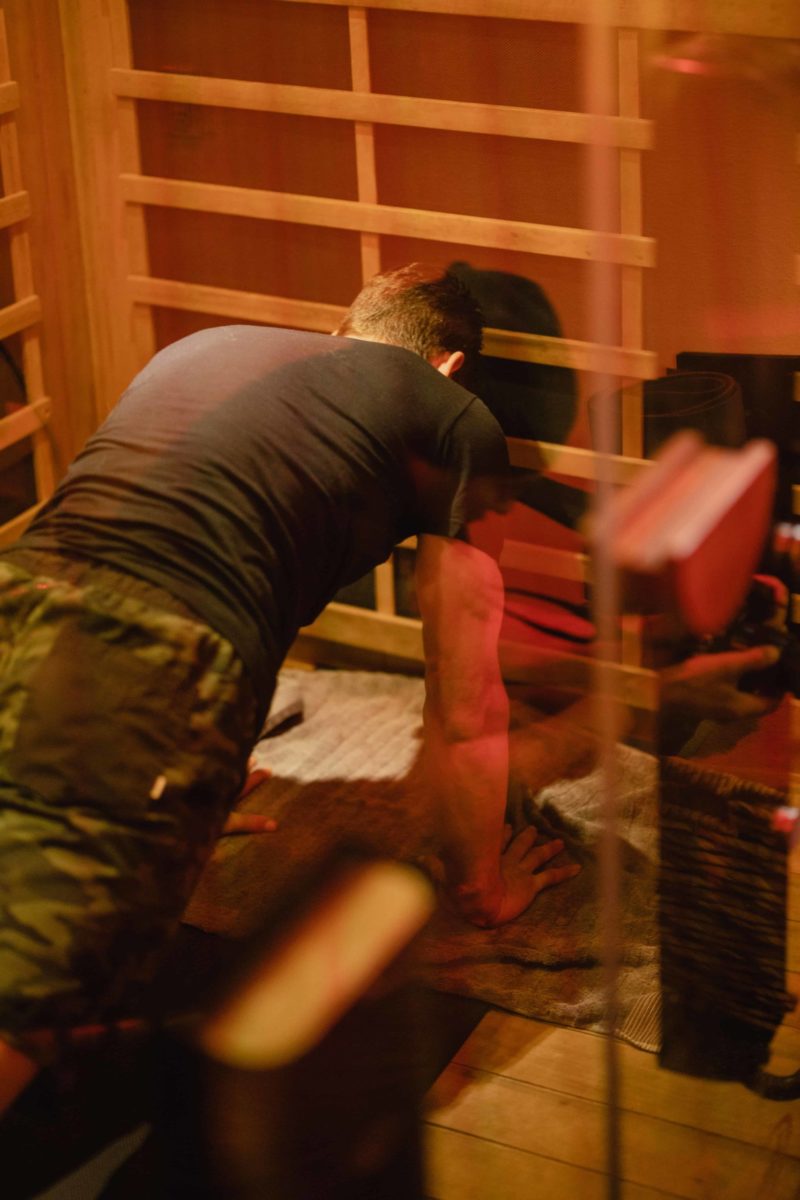 Heat stress triggers the release of heat shock proteins (HSPs), which prevent muscle damage by fighting free radicals and supporting antioxidant production. They also repair misfolded, damaged proteins in muscle tissue.
Heat stress triggers the release of heat shock proteins (HSPs), which prevent muscle damage by fighting free radicals and supporting antioxidant production. They also repair misfolded, damaged proteins in muscle tissue.
Research has shown that when rats experience heat stress, they experience 30% more muscle regrowth compared to a control group, due to the increase in HSPs. One particular HSP, coded by the HSP70 gene, has even been linked to increased longevity.
Other research has shown that two 20-minute sauna sessions, separated by a 30-minute cooling period, can elevate growth hormone levels twofold over baseline. Two 15-minute sauna sessions at an even warmer temperature with a 30-minute cooling period resulted in a fivefold increase in growth hormone.
When heat stress and exercise are combined, they induce a synergistic increase in growth hormone. This is why I often do isometrics, yoga, push-ups, and squats in my infrared sauna. Sauna exposure also increases blood flow to muscles, keeping them fueled with nutrients while removing metabolic byproducts, and it can even build new red blood cells at rates similar to illegal performance-enhancing drugs.
For more information on how to build and maintain muscle using a sauna, and to see the large sauna I use for exercise sessions, check out my article Ten Scientifically Proven Reasons I Am Addicted To A Daily Sauna, and for even more on sauna, including the latest research on the health benefits, take a look my recent article The Latest In Sauna Science: 9 Potent Health Benefits of Sauna, Plus 5 Tips for Getting the Most Out of Your Sweatbox Experience.
The Best Supplements For Muscle Building (Potent New Formulas)
There's a catch with all of this, though, that I need to mention.
You can follow a perfect resistance training protocol, implementing everything that I have outlined above, and still not get results.
So why have I bothered to cover this so extensively, then? Well, the thing is, everything I have outlined above is valid and effective, but only if your body has what it needs in terms of nutrition to build that healthy muscle.
 Now, I am not going to get into how to eat for optimal fitness, because I have covered this in-depth in the past (and, let's face it, I could write an article every single week the topic). Here are a few articles and podcasts you can start with if you want to learn more about nutrition and fitness:
Now, I am not going to get into how to eat for optimal fitness, because I have covered this in-depth in the past (and, let's face it, I could write an article every single week the topic). Here are a few articles and podcasts you can start with if you want to learn more about nutrition and fitness:
- The Real Truth About What To Eat Before, During And After Your Workouts & Races.
- What Should I Eat? The Ultimate Podcast Guide To Choosing The Perfect Diet For You: Part 1
- What Should I Eat? The Ultimate Podcast Guide To Choosing The Perfect Diet For You: Part 2
- The Benefits Of Fasted Exercise, Busting the Myth of the Pre and Post Workout Meal, Who Shouldn’t Fast & Much More!
While I'm not going to recap everything you need to know about nutrition and fitness, I do want to touch on the supplements that you should definitely consider adding if you want to get the most out of your resistance training. Over the years I have gotten countless questions about this subject as, let's face it, even with all of the knowledge in the world about nutrition, structuring the perfect diet for fitness and sticking to it day in and day out is probably not entirely realistic on a daily basis. There is no shortage of products out there that claim to build muscle fast. But grabbing a big vat of protein powder off the shelf of your local GNC is problematic when unhealthy and even ineffective ingredients abound. The reason that I founded Kion was to redefine energy solutions with products designed to give you energy for life in a totally natural and healthy way, and now I'm slowly building it to be a one-stop shop for supplements. The muscle-building lineup at Kion is now quite impressive, with Kion Aminos, Kion Creatine, Kion Colostrum, and the newest product, Kion Clean Protein, all part of my own daily regimen for optimal fitness. I also rely on Kion Omega Fish Oil and Kion Flex for their antiinflammatory and recovery benefits. Below, I'll give you a quick overview of each of the formulas I rely on daily to optimize my own muscle growth and maintenance
Muscle-Building Supplement #1: Kion Aminos
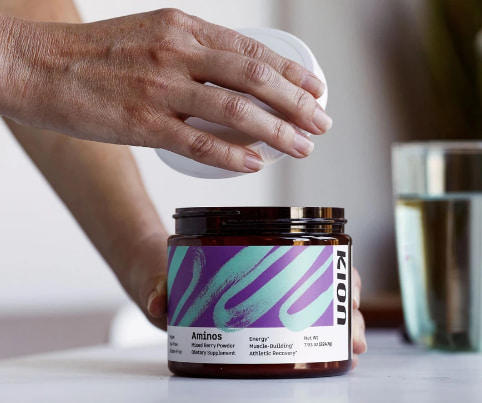 The friend that I mentioned at the start of this article said in his email to me that he was already planning out a protocol with Kion Aminos. He knows that aminos are critical building blocks for building and maintaining muscle mass and that Kion is my pick for an aminos supplement. Kion recently reformulated Aminos and the result is an amazing-tasting supplement that contains all nine amino acids and a comprehensive amino acid ratio that’s been clinically proven to maximize muscle protein synthesis and athletic recovery—all with no added sugar, artificial ingredients, chemicals, stimulants, or other nasty fillers.
The friend that I mentioned at the start of this article said in his email to me that he was already planning out a protocol with Kion Aminos. He knows that aminos are critical building blocks for building and maintaining muscle mass and that Kion is my pick for an aminos supplement. Kion recently reformulated Aminos and the result is an amazing-tasting supplement that contains all nine amino acids and a comprehensive amino acid ratio that’s been clinically proven to maximize muscle protein synthesis and athletic recovery—all with no added sugar, artificial ingredients, chemicals, stimulants, or other nasty fillers.
You can find my most comprehensive guide to amino acids yet, including why Kion is my hands-down top choice for aminos supplementation, in this recent article.
Muscle-Building Supplement #2: Kion Creatine
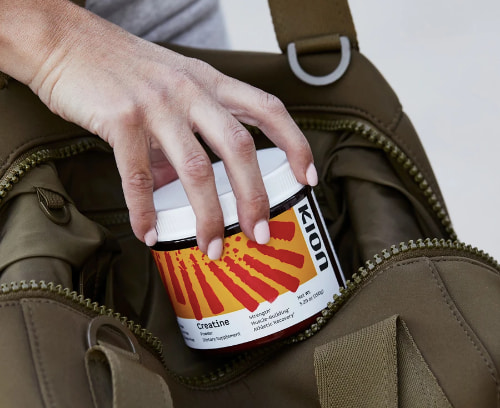 Creatine is one of the best supplements you can incorporate into your daily routine for boosting athletic performance, whether you're a bodybuilder or not. Creatine supplementation was also shown to have a positive effect on the preservation of muscle mass and strength in a study of young men whose arms were immobilized by casts. The creatine group better maintained lean tissue mass, elbow flexor strength and endurance, and elbow extensor strength and endurance.
Creatine is one of the best supplements you can incorporate into your daily routine for boosting athletic performance, whether you're a bodybuilder or not. Creatine supplementation was also shown to have a positive effect on the preservation of muscle mass and strength in a study of young men whose arms were immobilized by casts. The creatine group better maintained lean tissue mass, elbow flexor strength and endurance, and elbow extensor strength and endurance.
In another study, creatine supplementation was shown to provide an additive effect on blunting the rise of muscle damage markers following a repeated bout of resistance exercise. Lesser rises in serum creatine kinase activity, muscle soreness, and a lesser decrease in range of motion were all exhibited in the creatine group.
Kion Creatine is designed to supply muscles with a quick source of energy, so combined with resistance training, it helps to increase muscle strength and weightlifting performance. Creatine also helps to increase muscle mass and support fatigue resistance in older adults, where muscle fatigue and loss are both unfortunately quite common.
To get a more in-depth look at how creatine can help you build your muscle and keep it, and why I swear by it, check out this recent article.
Muscle-Building Supplement #3: Kion Colostrum
 Colostrum, also known as “first milk,” is produced by female mammals days before giving birth and then serves as a concentrated source of nutrition for newborns in their first days of life. Colostrum is rich in protein and tonic compounds and contains everything the human body needs to grow normally, such as nutrients, immune-enhancing compounds, and anabolic agents such as insulin-like growth factor (IGF-1). IGF-1 facilitates the growth of bone, muscle, and other tissues in the body. Due to its role in stimulating an increase in muscle volume and mass (a process known as hypertrophy), IGF-1 is important in building muscle and improving overall body composition.
Colostrum, also known as “first milk,” is produced by female mammals days before giving birth and then serves as a concentrated source of nutrition for newborns in their first days of life. Colostrum is rich in protein and tonic compounds and contains everything the human body needs to grow normally, such as nutrients, immune-enhancing compounds, and anabolic agents such as insulin-like growth factor (IGF-1). IGF-1 facilitates the growth of bone, muscle, and other tissues in the body. Due to its role in stimulating an increase in muscle volume and mass (a process known as hypertrophy), IGF-1 is important in building muscle and improving overall body composition.
One study found that colostrum supplementation during resistance training was beneficial for improving leg press strength, upper body strength, muscle thickness, and lean tissue mass. Another study found that eight to 12 weeks of bovine colostrum supplementation during a resistance training program increased lean tissue mass by 1.5 to 2 kg. Colostrum was also shown to reduce post-exercise muscle damage in a study conducted on young, male soccer players.
Colostrum, a nutritional powerhouse, is an important addition to your muscle-building and recovery routine. You can read much more about colostrum in this article that was updated in 2020 with all the most recent updates and findings.
Muscle-Building Supplement #4: Kion Clean Protein
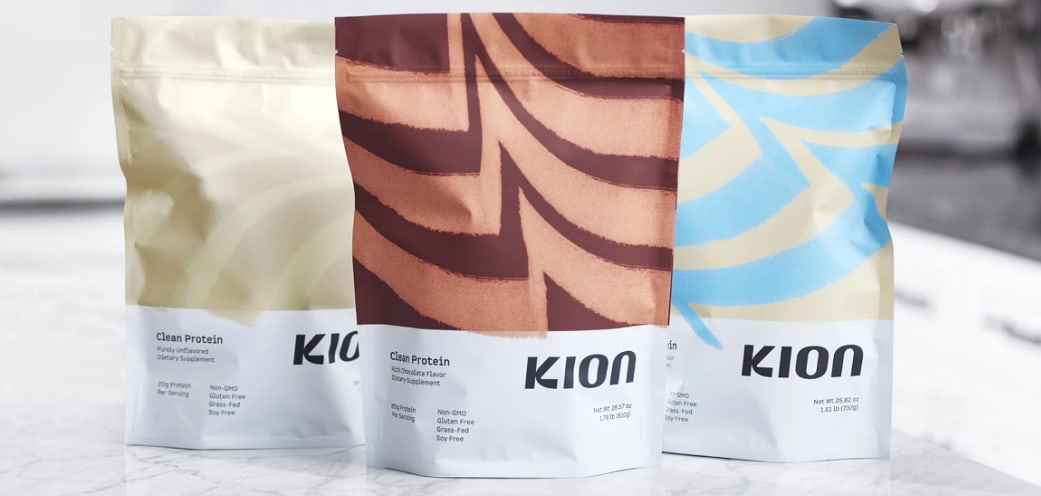 At the time that my friend emailed me back in August, I was unable to recommend Kion Clean Protein to him because it was not yet available, but I am most definitely contacting him now about this brand-new product, which has quickly become indispensable to me (and is scooped into my morning smoothie daily along with Aminos).
At the time that my friend emailed me back in August, I was unable to recommend Kion Clean Protein to him because it was not yet available, but I am most definitely contacting him now about this brand-new product, which has quickly become indispensable to me (and is scooped into my morning smoothie daily along with Aminos).
Protein is a vital macronutrient that promotes muscle growth and repair, metabolism, sleep, skin and nails, brain function, the immune system, and so much more. Because protein is used for just about every bodily process, it’s constantly being broken down and must be replaced with adequate amounts from your diet. While there are plenty of different kinds of protein powders out on the market, whey protein is far superior to others for muscle-building for the following reasons:
- Whey protein contains the highest levels of all the EAAs (essential amino acids, or those that can't be made by your own body), which are the building blocks of protein.
- Whey protein is chock-full of branched-chain amino acids (BCAAs) such as isoleucine, valine—and especially leucine, which is the most important amino acid when it comes to stimulating muscle growth and repair.
- Whey protein offers the highest amount of protein per calorie, which means you'll get full faster while building lean muscle.
- Whey protein has been proven to be a highly effective post-workout recovery aid.
Sufficient protein intake is critical for building and maintaining muscle mass. There has been a great deal of confusion out there about how much protein constitutes adequate, though. In last week's article, The Ultimate Guide to Protein & Protein Powders, The Truth About Whey Protein Isolate, Protein Dosing/Timing Guide & My Brand New Rich, Creamy, Delicious Clean Protein Smoothie Recipe)., I give you a thorough look at the latest research that supports the superiority of whey protein and get further into the recommendations for how much protein you need based on your age, activity level, whether you eat meat, and more.
Muscle-Building Supplement #5: Kion Omega Fish Oil
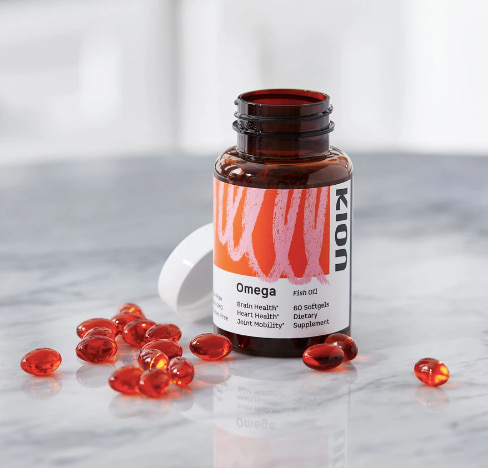 If you struggle with sub-par exercise recovery, achy joints, or excess soreness from exercise, Omega-3s can help. A recent randomized, double-blind, placebo-controlled study on healthy young men showed promising results from eight weeks of Omega-3 supplementation (600 mg EPA, 260 mg DHA). According to the study, “DHA and EPA supplementation may play a protective role against motor nerve function and may attenuate damage after eccentric contractions.” Another study using a much higher dose (1.86 g EPA, 1.5 g DHA) showed Omega-3s stimulated muscle protein synthesis in older adults. This means Omega-3s may help build muscle, as well!
If you struggle with sub-par exercise recovery, achy joints, or excess soreness from exercise, Omega-3s can help. A recent randomized, double-blind, placebo-controlled study on healthy young men showed promising results from eight weeks of Omega-3 supplementation (600 mg EPA, 260 mg DHA). According to the study, “DHA and EPA supplementation may play a protective role against motor nerve function and may attenuate damage after eccentric contractions.” Another study using a much higher dose (1.86 g EPA, 1.5 g DHA) showed Omega-3s stimulated muscle protein synthesis in older adults. This means Omega-3s may help build muscle, as well!
Kion Omega Fish Oil is a high-quality EPA and DHA fish oil that supports total body wellness in addition to enhanced athletic recovery. Most people don't get the Omega-3 fatty acids they need on a regular basis from foods they eat, so it's important to supplement. Best of all? Kion Fish Oil is made from sustainably sourced cold-water anchovies preserved with antioxidants so you're getting one heck of a useful, and top-shelf, supplement.
If you're interested in learning more about omegas, why you should care about them, and how to get more of them into your diet for athletic recovery purposes, check out this article.
Muscle-Building Supplement #6: Kion Flex
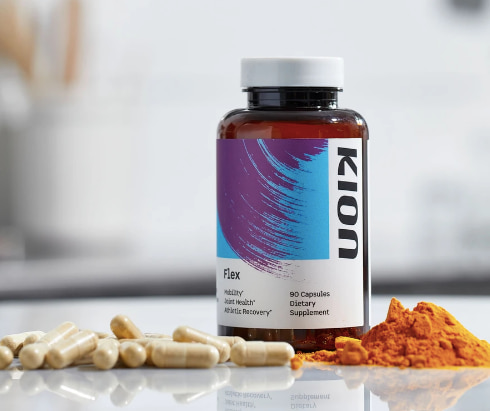 Kion Flex is a fast-acting blend of natural ingredients is specifically designed to support your active lifestyle. It keeps you on the move with the ability to help decrease exercise-related muscle swelling and soreness, supports joint health and functionality, and reduces mild joint discomfort from overuse. Kion Flex is a go-to supplement in my everyday workout routine to sustain my activity levels without worrying about muscle soreness and stiffness.
Kion Flex is a fast-acting blend of natural ingredients is specifically designed to support your active lifestyle. It keeps you on the move with the ability to help decrease exercise-related muscle swelling and soreness, supports joint health and functionality, and reduces mild joint discomfort from overuse. Kion Flex is a go-to supplement in my everyday workout routine to sustain my activity levels without worrying about muscle soreness and stiffness.
Unfortunately, even the healthiest and most limber of people suffer from muscle soreness and stiffness, especially combined with a more active lifestyle. But you can continue doing what you love, whether it be running, jumping, dancing, or any sort of movement, with Kion Flex due to its powerful muscle recovery components.
The six supplements above are all integral parts of my daily muscle-building and recovery regimens. While each on its own provides distinct benefits, when you stack them together you will have optimal results. Kion products are research-backed and quality tested, made with clean ingredients, and provide natural energy without the artificial boost or crash—so I feel really good about what I'm putting into my body, and it's one of the most potent muscle-building and recovery stacks I've ever used.
Summary
Hopefully, you'll never be in my friend's situation, whereby an illness or other circumstance results in a sudden decrease in muscle mass.
Now, though, regardless of whether you are looking to reclaim your muscular fitness, build it up for the first time, or maintain your already hard-earned biceps of steel, you have the information and tools you need to not only shape your body but to benefit from the potent anti-aging effects, too.
Here are a few key takeaways from this article:
- Bigger muscles aren’t necessarily better. You want lean, wiry, explosive muscles capable of exerting enormous amounts of force relative to their size.
- You can achieve this type of muscle with as little as two strength workouts per week, one super-slow lifting workout, and one explosive 7-minute bodyweight workout.
- Weightlifting and load-bearing workouts not only build muscle, but also improve insulin resistance and fat metabolism, and reduce the effects of aging on mitochondria and your telomeres.
- You can build muscle and strength with just bodyweight workouts.
- You can also build and maintain muscle using EMS and heat stress.
- Supplementing with the right formulas will provide your body with the building blocks necessary to develop and maintain healthy muscle. I recommend the Kion suite of products for their quality and effectiveness—Aminos, Creatine, Colostrum, Clean Protein, Omega Fish Oil, and Flex.
You’re now equipped to use the most research-backed methods for building and maintaining lean, healthy muscle that will have you looking and feeling good well into old age. Trust me: your body will thank you.
How about you? Is resistance training a part of your workout protocol? Have you ever, like my friend, had an unwanted drop in muscle mass that required that you build back up? If so, what worked? I'd love to hear from you in the comments below.


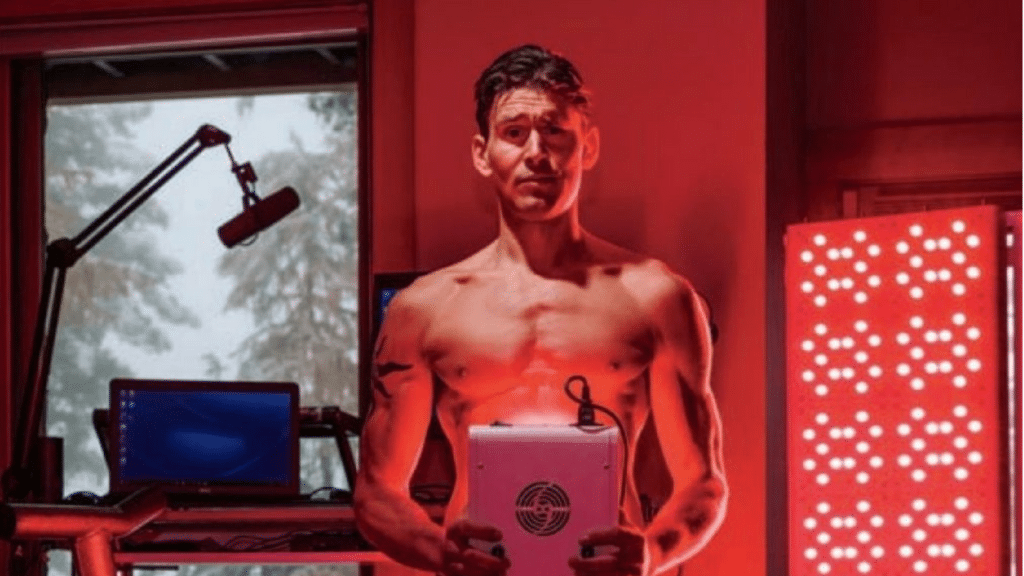


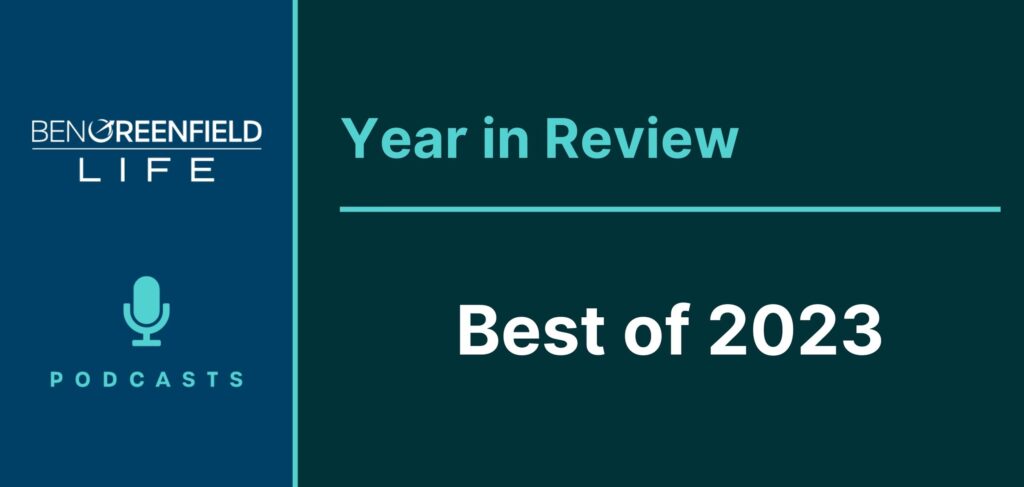



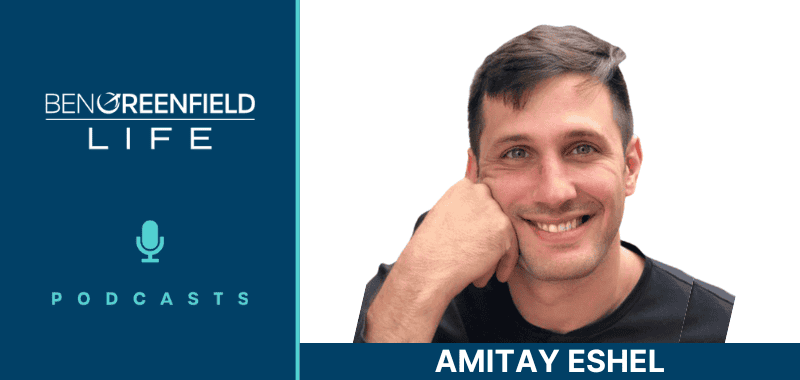




Hey Ben, I really appreciate your article as it is a motivating read. I was a skinny guy and now looking back I also want others to reach the best fitness levels and I will surely recommend my peers and family to give this a look also. cheers man.